lock Lancia Thesis 2007 Owner handbook (in English)
[x] Cancel search | Manufacturer: LANCIA, Model Year: 2007, Model line: Thesis, Model: Lancia Thesis 2007Pages: 386, PDF Size: 8.69 MB
Page 323 of 386
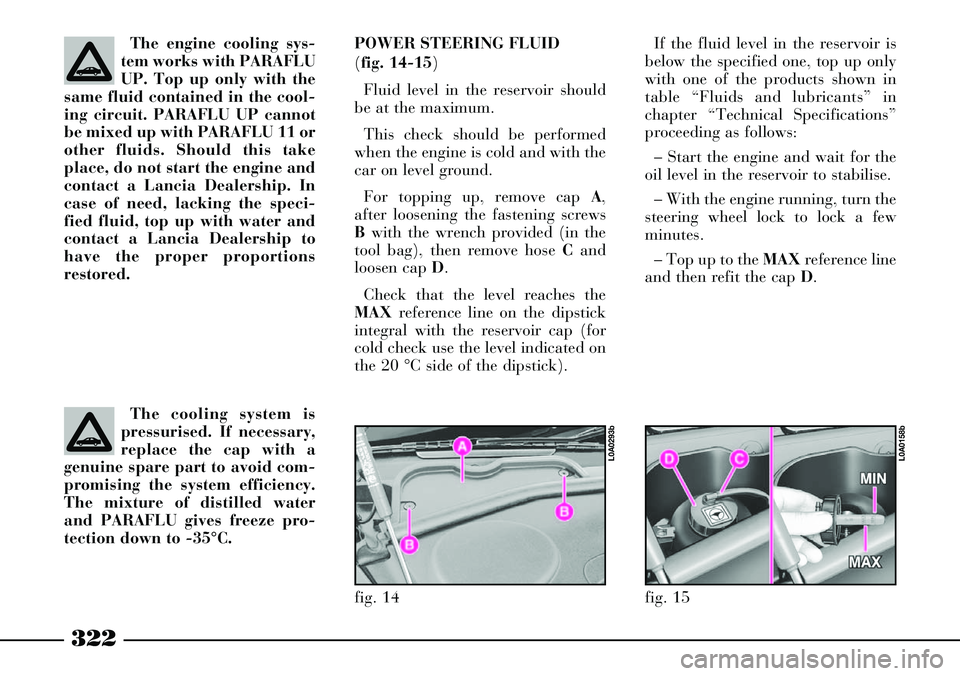
322
fig. 14
L0A0293b
fig. 15
L0A0158b
The engine cooling sys-
tem works with PARAFLU
UP. Top up only with the
same fluid contained in the cool-
ing circuit. PARAFLU UP cannot
be mixed up with PARAFLU 11 or
other fluids. Should this take
place, do not start the engine and
contact a Lancia Dealership. In
case of need, lacking the speci-
fied fluid, top up with water and
contact a Lancia Dealership to
have the proper proportions
restored.
The cooling system is
pressurised. If necessary,
replace the cap with a
genuine spare part to avoid com-
promising the system efficiency.
The mixture of distilled water
and PARAFLU gives freeze pro-
tection down to -35°C. POWER STEERING FLUID
(fig. 14-15)
Fluid level in the reservoir should
be at the maximum.
This check should be performed
when the engine is cold and with the
car on level ground.
For topping up, remove cap A,
after loosening the fastening screws
Bwith the wrench provided (in the
tool bag), then remove hose Cand
loosen cap D.
Check that the level reaches the
MAXreference line on the dipstick
integral with the reservoir cap (for
cold check use the level indicated on
the 20 °C side of the dipstick).If the fluid level in the reservoir is
below the specified one, top up only
with one of the products shown in
table “Fluids and lubricants” in
chapter “Technical Specifications”
proceeding as follows:
– Start the engine and wait for the
oil level in the reservoir to stabilise.
– With the engine running, turn the
steering wheel lock to lock a few
minutes.
– Top up to the MAXreference line
and then refit the cap D.
Page 335 of 386
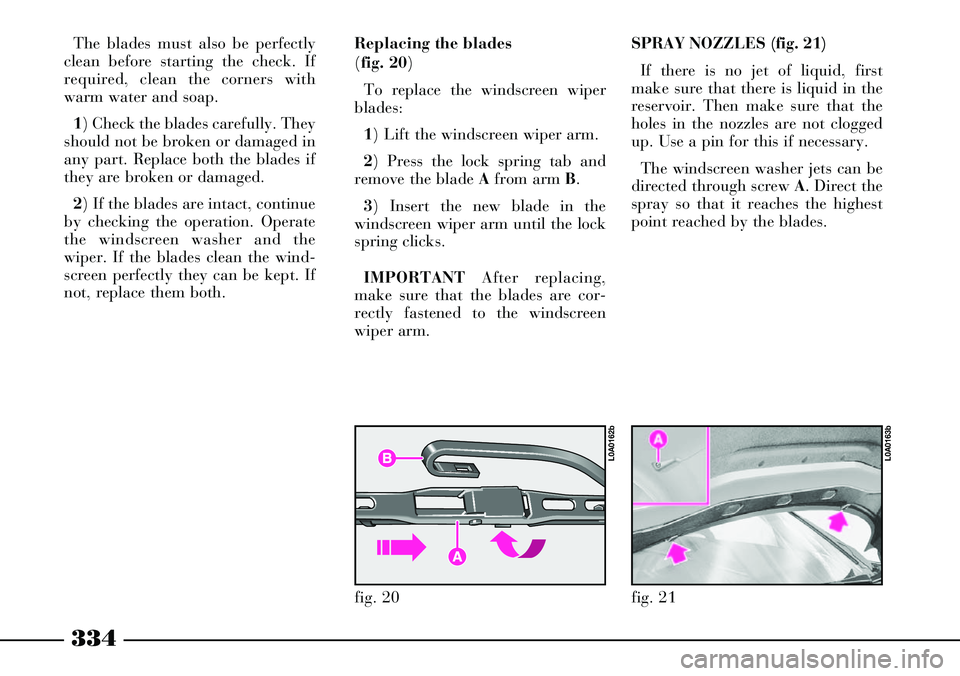
334
SPRAY NOZZLES (fig. 21)
If there is no jet of liquid, first
make sure that there is liquid in the
reservoir. Then make sure that the
holes in the nozzles are not clogged
up. Use a pin for this if necessary.
The windscreen washer jets can be
directed through screw A. Direct the
spray so that it reaches the highest
point reached by the blades.
fig. 21
L0A0163b
The blades must also be perfectly
clean before starting the check. If
required, clean the corners with
warm water and soap.
1) Check the blades carefully. They
should not be broken or damaged in
any part. Replace both the blades if
they are broken or damaged.
2) If the blades are intact, continue
by checking the operation. Operate
the windscreen washer and the
wiper. If the blades clean the wind-
screen perfectly they can be kept. If
not, replace them both.Replacing the blades
(fig. 20)
To replace the windscreen wiper
blades:
1) Lift the windscreen wiper arm.
2) Press the lock spring tab and
remove the blade Afrom arm B.
3) Insert the new blade in the
windscreen wiper arm until the lock
spring clicks.
IMPORTANTAfter replacing,
make sure that the blades are cor-
rectly fastened to the windscreen
wiper arm.
fig. 20
L0A0162b
Page 336 of 386

335
HEADLIGHT
WASHERS
Regularly check that the nozzles
(fig. 22) are intact and clean.
The headlight washers are auto-
matically switched on when the
windscreen washer is operated and
the headlights are on.
CLIMATE
CONTROL SYSTEM
During the winter, the climate con-
trol system must be turned on at
least once a month for about ten
minutes.
Before summer, have the system
checked at a Lancia Dealership.INITIALISING THE AIR
CONDITIONING CONTROL UNIT
Whenever the battery is electrically
connected again or it is reloaded after
being completely flat or after replac-
ing one of the protection fuses, to re-
store the correct operation of the air
conditioning, of the door locking and
of the ESP system. It is necessary to
perform the initialisation operations
contained in the paragraph “If battery
is to be disconnected” in the chapter
“In an emergency”.
fig. 22
L0A0122b
The system is filled with
R134a refrigerant which
will not pollute the envi-
ronment in the event of leakage.
Under no circumstances should
R12 fluid be used as it is incom-
patible with the system compo-
nents and contains CFC.
Page 338 of 386
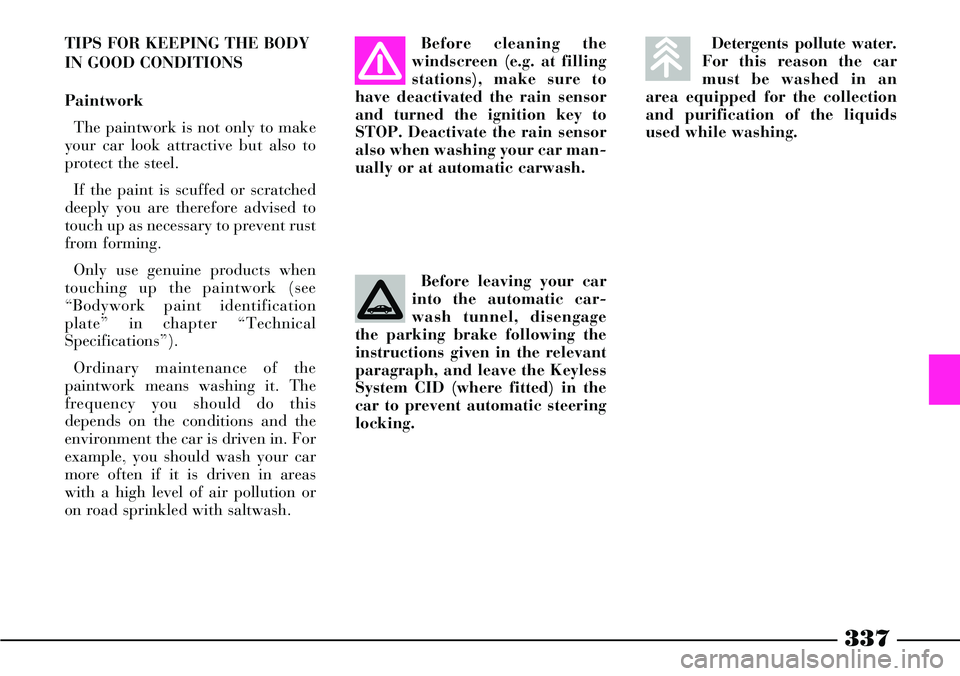
337
Detergents pollute water.
For this reason the car
must be washed in an
area equipped for the collection
and purification of the liquids
used while washing.TIPS FOR KEEPING THE BODY
IN GOOD CONDITIONS
Paintwork
The paintwork is not only to make
your car look attractive but also to
protect the steel.
If the paint is scuffed or scratched
deeply you are therefore advised to
touch up as necessary to prevent rust
from forming.
Only use genuine products when
touching up the paintwork (see
“Bodywork paint identification
plate” in chapter “Technical
Specifications”).
Ordinary maintenance of the
paintwork means washing it. The
frequency you should do this
depends on the conditions and the
environment the car is driven in. For
example, you should wash your car
more often if it is driven in areas
with a high level of air pollution or
on road sprinkled with saltwash.Before leaving your car
into the automatic car-
wash tunnel, disengage
the parking brake following the
instructions given in the relevant
paragraph, and leave the Keyless
System CID (where fitted) in the
car to prevent automatic steering
locking.Before cleaning the
windscreen (e.g. at filling
stations), make sure to
have deactivated the rain sensor
and turned the ignition key to
STOP. Deactivate the rain sensor
also when washing your car man-
ually or at automatic carwash.
Page 341 of 386

340
CLEANING VELVET SEATS
AND FABRICS
– Remove dust with a soft brush
and vacuum cleaner. Use a moist
brush to clean velvet upholstery.
– Brush the seats with a damp
sponge with water and a neutral
soap.CLEANING LEATHER SEATS
– Remove the dry dirt with a
chamois leather or very slightly
moist loth without exerting too
much pressure.
– Remove liquid or grease stains
with a dry absorbent cloth without
rubbing. Then wipe with a chamois
leather or soft cloth moistened with
water and neutral soap. If the stain
does not come out, use a special
cleaning compound being particu-
larly careful to follow the instruc-
tions for use.
IMPORTANTNever use alcohol or
alcohol-based products.STEERING WHEEL/GEAR
LEVER KNOB WITH GENUINE
LEATHER COVERING
These components shall only be
cleaned with water and neutral soap.
Never use spirit or alcohol-based
products.
Before using special products for
cleaning interiors, read carefully label
instructions and indications to make
sure they are free from spirit and/or
alcohol-based substances.
If when cleaning the windscreen
with special glass products, some
drops fall on the leather covering of
the steering wheel/gear lever knob re-
move them immediately and then
clean with water and neutral soap.
IMPORTANT Take the utmost care
when engaging the steering lock to
prevent scratching the leather cover-
ing. Upholstery of your car
has been designed to with-
stand wear deriving from
common use of the car. You are
however recommended to avoid
strong and/or continuous scratch-
ing with clothing accessories such
as metallic buckles, studs, Velcro
fastenings and the like, since these
items cause circumscribed stress
of the cover fabric that could lead
to yarn breaking, and damage the
cover as a consequence.
Page 342 of 386
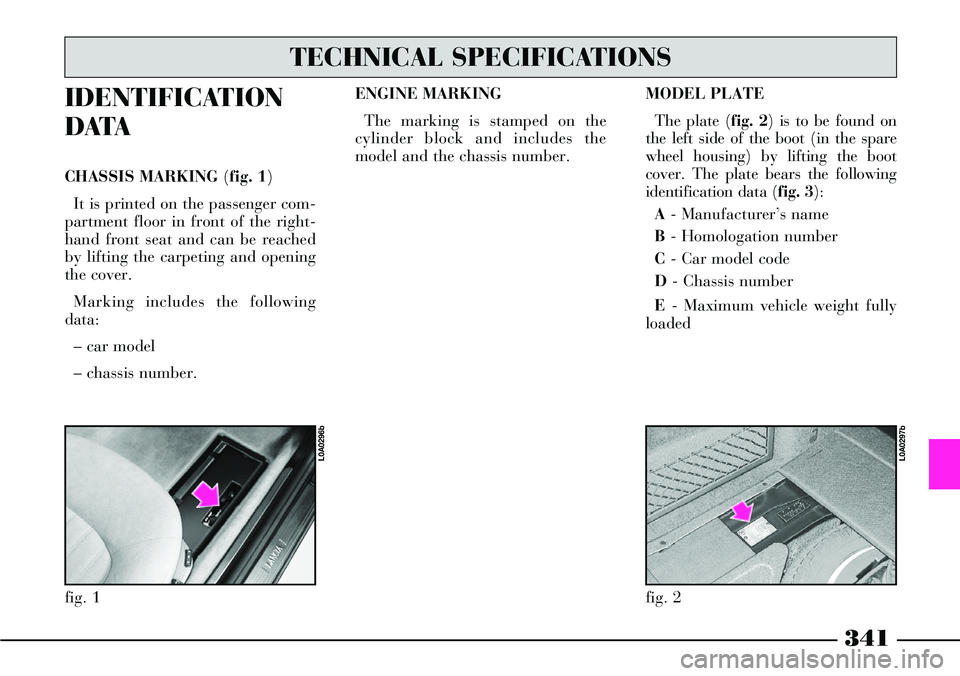
341
IDENTIFICATION
DATA
CHASSIS MARKING (fig. 1)
It is printed on the passenger com-
partment floor in front of the right-
hand front seat and can be reached
by lifting the carpeting and opening
the cover.
Marking includes the following
data:
– car model
– chassis number.ENGINE MARKING
The marking is stamped on the
cylinder block and includes the
model and the chassis number.
fig. 1
L0A0296b
fig. 2
L0A0297b
TECHNICAL SPECIFICATIONS
MODEL PLATE
The plate (fig. 2) is to be found on
the left side of the boot (in the spare
wheel housing) by lifting the boot
cover. The plate bears the following
identification data (fig. 3):
A- Manufacturer’s name
B- Homologation number
C- Car model code
D- Chassis number
E- Maximum vehicle weight fully
loaded
Page 353 of 386
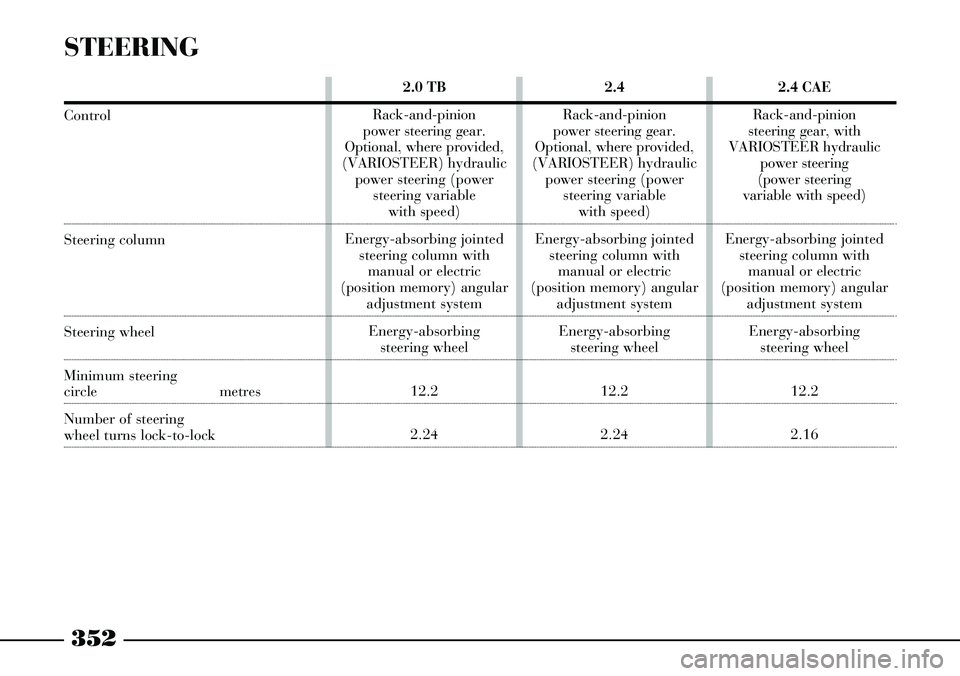
352
2.4
Rack-and-pinion
power steering gear.
Optional, where provided,
(VARIOSTEER)hydraulic
power steering (power
steering variable
with speed)
Energy-absorbing jointed
steering column with
manual or electric
(position memory) angular
adjustment system
Energy-absorbing
steering wheel
12.2
2.24 2.0 TB
Rack-and-pinion
power steering gear.
Optional, where provided,
(VARIOSTEER)hydraulic
power steering (power
steering variable
with speed)
Energy-absorbing jointed
steering column with
manual or electric
(position memory) angular
adjustment system
Energy-absorbing
steering wheel
12.2
2.24 2.4 CAE
Rack-and-pinion
steering gear, with
VARIOSTEER hydraulic
power steering
(power steering
variable with speed)
Energy-absorbing jointed
steering column with
manual or electric
(position memory) angular
adjustment system
Energy-absorbing
steering wheel
12.2
2.16
STEERING
Control
Steering column
Steering wheel
Minimum steering circle metres
Number of steering
wheel turns lock-to-lock
Page 354 of 386
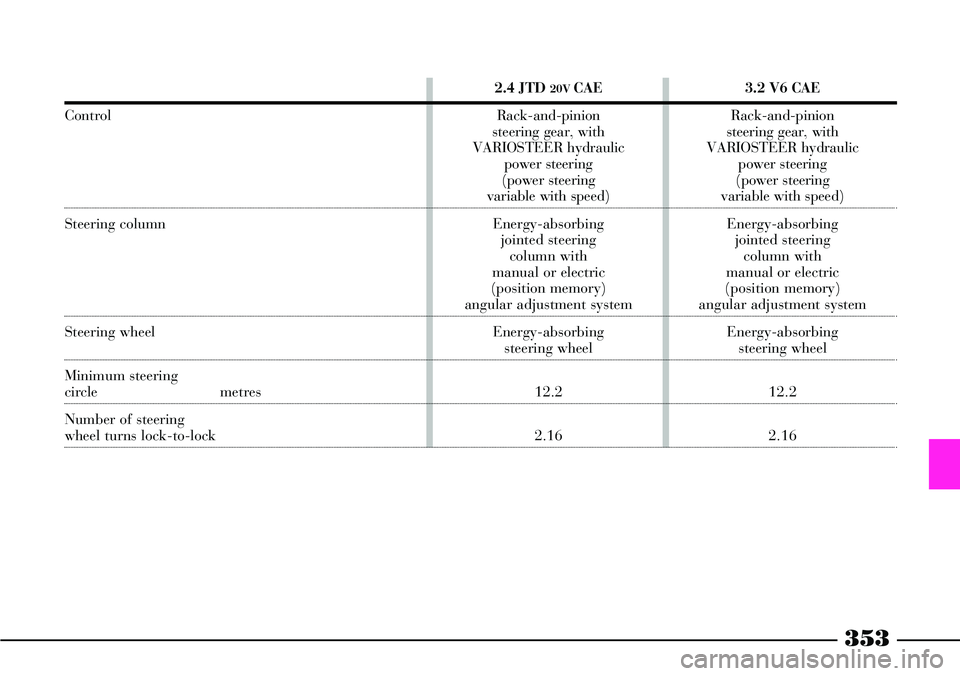
353
2.4 JTD 20V CAE
Rack-and-pinion
steering gear, with
VARIOSTEER hydraulic
power steering
(power steering
variable with speed)
Energy-absorbing
jointed steering
column with
manual or electric
(position memory)
angular adjustment system
Energy-absorbing
steering wheel
12.2
2.163.2 V6 CAE
Rack-and-pinion
steering gear, with
VARIOSTEER hydraulic
power steering
(power steering
variable with speed)
Energy-absorbing
jointed steering
column with
manual or electric
(position memory)
angular adjustment system
Energy-absorbing
steering wheel
12.2
2.16
Control
Steering column
Steering wheel
Minimum steering circle metres
Number of steering
wheel turns lock-to-lock
Page 371 of 386

370
Battery
- checking the battery
charge ................................ 327
- disconnecting the loaded
battery ............................... 302
- disconnecting the
unloaded battery................ 303
- initialising the control
units of the door locks,
air conditioner and ESP
system................................ 303
- jump starting ............. 272-304
- maintenance ..................... 326
- recharging the
battery ...................... 304-328
- replacement ...................... 328
- useful advice ..................... 329
Bodywork
- maintenance ..................... 337
- version code ...................... 343Bodywork paint
identification plate .............. 342
Bodywork versions (codes) ..... 343
Bonnet .................................... 237
Boot
- anchoring the load ............ 232
- ceiling light ........................ 231
- closing the boot.................. 231
- functions that can be
modified by the
CONNECT menu ............... 229
- luggage nets ....................... 231
- luggage transport -
important notes ................. 233
- opening by remote
control ............................... 228
- opening from the inside .... 227
- opening from the outside
with the key ....................... 228
- power socket ..................... 234
Boot light
- bulb replacement ............... 290Bose HI-FI audio system ........ 248
Bottle/can holder
- front ................................. 217
- rear ................................... 219
Brake and hydraulic
clutch fluid .......................... 323
Brakes
- fluid level ......................... 323
- technical specifications ...... 348
Bulbs (replacing) .................... 281
- bulbs ................................. 283
- front light cluster ............... 284
- general instructions ........... 282
- rear light cluster ................ 286
- replacing an exterior light .. 284
- types of bulbs ................... 282
Capacities ............................. 362
Car maintenance .................. 309
- additional checks .............. 314
Page 372 of 386
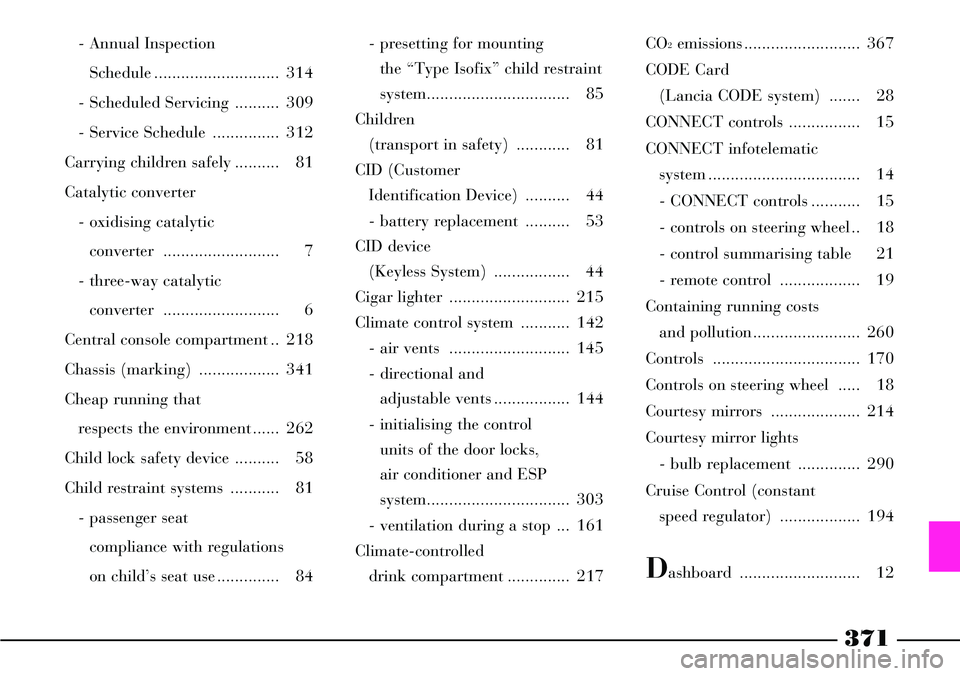
371
- Annual Inspection
Schedule ............................ 314
- Scheduled Servicing .......... 309
- Service Schedule ............... 312
Carrying children safely .......... 81
Catalytic converter
- oxidising catalytic
converter .......................... 7
- three-way catalytic
converter .......................... 6
Central console compartment .. 218
Chassis (marking) .................. 341
Cheap running that
respects the environment ...... 262
Child lock safety device .......... 58
Child restraint systems ........... 81
- passenger seat
compliance with regulations
on child’s seat use .............. 84- presetting for mounting
the “Type Isofix” child restraint
system................................ 85
Children
(transport in safety) ............ 81
CID (Customer
Identification Device) .......... 44
- battery replacement .......... 53
CID device
(Keyless System) ................. 44
Cigar lighter ........................... 215
Climate control system ........... 142
- air vents ........................... 145
- directional and
adjustable vents ................. 144
- initialising the control
units of the door locks,
air conditioner and ESP
system................................ 303
- ventilation during a stop ... 161
Climate-controlled
drink compartment .............. 217CO2emissions .......................... 367
CODE Card
(Lancia CODE system) ....... 28
CONNECT controls ................ 15
CONNECT infotelematic
system .................................. 14
- CONNECT controls ........... 15
- controls on steering wheel .. 18
- control summarising table 21
- remote control .................. 19
Containing running costs
and pollution ........................ 260
Controls ................................. 170
Controls on steering wheel ..... 18
Courtesy mirrors .................... 214
Courtesy mirror lights
- bulb replacement .............. 290
Cruise Control (constant
speed regulator) .................. 194
Dashboard ........................... 12